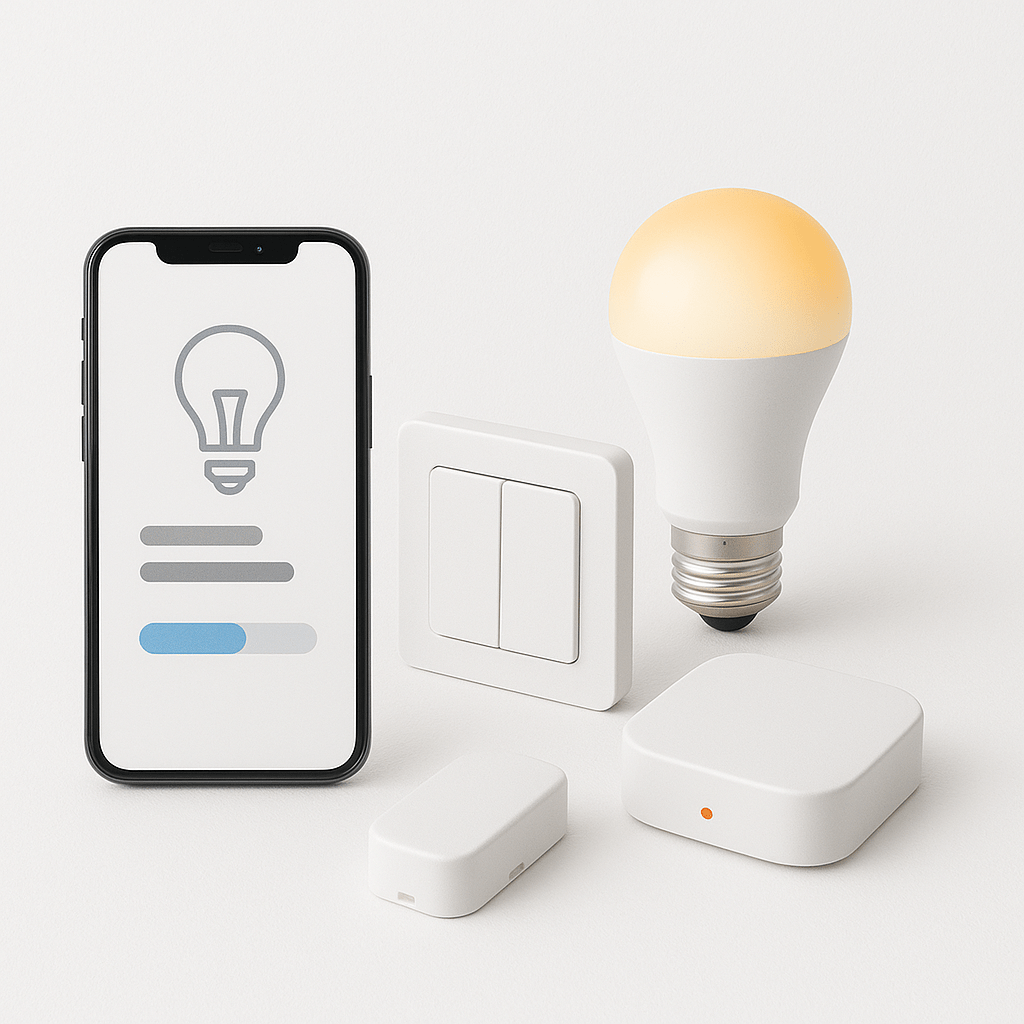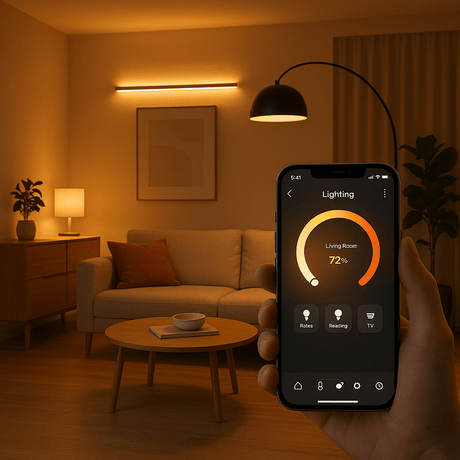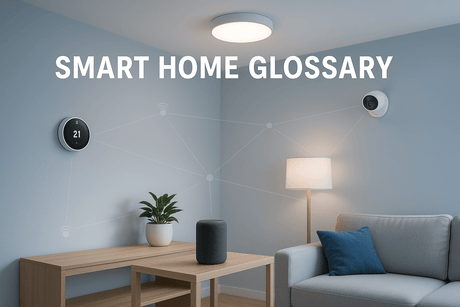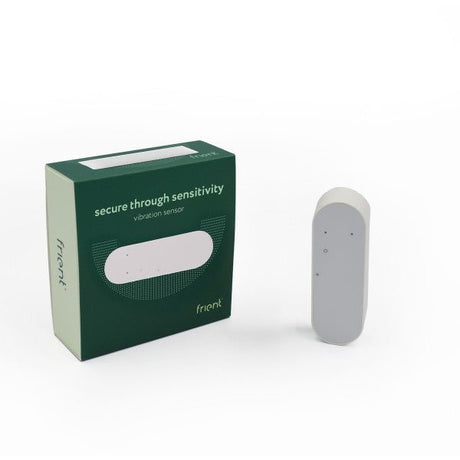Smart lighting is often the gateway into the world of home automation. It offers immediate benefits in convenience, ambiance, energy efficiency, and security. However, navigating the different control methods – smart switches, smart bulbs, and smart modules – can be confusing for newcomers. Each approach has distinct advantages, disadvantages, installation requirements, and ideal use cases. Understanding these differences is key to designing a smart lighting system that truly meets your needs and integrates seamlessly into your lifestyle.
This guide provides a comprehensive comparison of smart switches, smart bulbs, and smart modules (often called inline relays or dimmers), focusing on solutions compatible with robust smart home protocols like Z-Wave and Zigbee, to help you make informed decisions for your Vesternet-powered smart home.

The Core Concepts: How They Differ
Before diving into pros and cons, let's clarify the fundamental difference:
- Smart Bulbs: The intelligence resides within the bulb itself. They replace your existing bulbs but require the light fixture's power switch to remain physically ON at all times to be controllable via app, voice, or automation. Turning off the physical switch cuts power to the bulb, rendering it "dumb."
- Smart Switches/Dimmers: The intelligence resides within the wall switch. They replace your existing wall switch and control the flow of power to the entire light fixture. The bulbs connected to the fixture remain standard "dumb" bulbs. The switch itself can be controlled physically, via app, voice, or automation.
- Smart Modules (Inline/Relay/Dimmer): The intelligence resides within a small module installed behind the existing wall switch or near the light fixture in the ceiling. Like smart switches, they control power to the fixture using standard bulbs, but they allow you to keep your existing physical wall switch aesthetic.
Smart Bulbs: Simplicity and Colour
Smart bulbs are often the easiest entry point into smart lighting.
Pros:
- Easy Installation: Simply screw the bulb into an existing socket. No wiring required.
- Colour and Temperature Control: Many smart bulbs offer adjustable white temperatures (cool to warm white) and full RGB colour capabilities, allowing for dynamic ambiance creation.
- Individual Bulb Control: Each smart bulb can often be controlled independently, even if multiple bulbs are in the same fixture (though grouping is common).
- Ideal for Renters: No permanent wiring changes make them perfect for apartments or rental properties.
- Good for Lamps: Excellent for table lamps and floor lamps where wall switch control isn't the primary method.
Cons:
- The "Always On" Switch Problem: The biggest drawback. The physical wall switch controlling the fixture must remain ON for the bulb to be smart. If someone instinctively flips the switch OFF, the bulb loses power and cannot be controlled remotely or via automation until the switch is turned back ON. This can be a constant source of frustration, especially in households with guests or children.
- Cost per Bulb: Equipping a fixture with multiple smart bulbs can become significantly more expensive than using a single smart switch or module with standard bulbs.
- Limited Fixture Types: Less practical for fixtures with non-standard bulb types or integrated LED fixtures where the "bulb" cannot be replaced.
- Potential Network Congestion (Wi-Fi Bulbs): While Zigbee bulbs are common and integrate well with hubs, many cheap smart bulbs use Wi-Fi, which can clutter your network if you have many devices.
-
No Control of Other Devices: A smart bulb only controls itself; it cannot control a ceiling fan connected to the same switch.

Best For:
- Renters or those unable to modify wiring.
- Specific lamps or fixtures where colour changing or temperature tuning is the primary goal.
- Users who can reliably train household members (or use switch guards) to leave physical switches ON.
- Rooms where individual bulb control within a multi-bulb fixture is desired.
Smart Switches/Dimmers: Seamless Integration
Smart switches and dimmers replace your existing wall switches, offering a more integrated and intuitive experience.
Pros:
- Intuitive Operation: Works just like a traditional switch – anyone can walk into a room and turn the lights on or off physically at the wall. This maintains usability for everyone, regardless of their tech-savviness.
- Controls Entire Fixture: Controls all bulbs connected to that switch simultaneously.
- Cost-Effective for Multi-Bulb Fixtures: One smart switch controlling several standard (and inexpensive) bulbs is usually much cheaper than multiple smart bulbs.
- Works with Standard Bulbs: No need for expensive, specialized bulbs. Compatible with most dimmable LEDs, incandescent, or halogen bulbs (check dimmer compatibility).
- Clean Aesthetic: Provides a modern, integrated look.
- Adds Home Value: Integrated smart wiring is often seen as a desirable home feature.
- Can Control Fans/Other Loads: Some smart switches are rated for motor loads and can control ceiling fans (ensure compatibility).
Cons:
- Requires Wiring Installation: Replacing a switch involves working with electrical wiring. While often straightforward for DIYers, it requires understanding basic wiring and safety precautions, or hiring an electrician.
- Neutral Wire Often Required: Most smart switches/dimmers need a neutral wire in the switch box for power. Older homes may not have neutral wires readily available in all switch boxes, limiting installation options or requiring workarounds.
- No Individual Bulb Control: Cannot control bulbs within the same fixture independently.
- No Colour Control (Directly): Smart switches control power and brightness (dimmers), but cannot change the colour of standard bulbs.
- Physical Space: Some smart switches are bulkier than traditional switches and may be a tight fit in shallow or crowded electrical boxes.
Neutral Wire Workarounds (If Missing):
- Check if the neutral wire is bundled but unused in the back of the box.
- Use specific "no-neutral" smart switches/dimmers (these often have limitations or require specific bypass capacitors).
- Use smart bulbs instead.
- Use smart modules installed at the fixture in the ceiling (where neutral is usually available).
-
Have an electrician run a neutral wire to the switch box (most complex/costly option).

Best For:
- Homeowners seeking a seamless, integrated smart lighting solution.
- Rooms with multi-bulb fixtures, recessed lighting, or chandeliers.
- Maintaining traditional, intuitive wall switch operation for family and guests.
- Situations where colour changing is not a primary requirement.
- Adding value to the property through integrated smart home features.
Smart Modules (Inline/Relay): Hidden Versatility
Smart modules offer a clever way to add smart control without altering the appearance of your existing switches or fixtures.
Pros:
- Invisible Installation: The module is hidden behind the existing switch plate or within the ceiling void near the fixture, preserving your home's aesthetic and allowing you to keep unique or decorative switch styles.
- Works with Existing Switches: Can often be configured to work with various switch types, including standard toggle switches or momentary (retractive) switches, maintaining physical control.
- Controls Entire Fixture: Like smart switches, they control the power to all bulbs connected to that circuit.
- High Versatility: Modules aren't limited to lighting. Depending on the model and load capacity, they can potentially control ceiling fans, bathroom extractors, switched outlets, or other wired appliances.
- Cost-Effective for Multi-Bulb Fixtures: Similar cost-benefit to smart switches when controlling fixtures with multiple standard bulbs.
- Neutral Wire Flexibility: While many modules require a neutral wire at the switch, some are designed to be installed at the light fixture in the ceiling, where a neutral wire is almost always present.
- Good for Multi-Way Switching: Specific modules and wiring configurations can elegantly solve complex 2-way or 3-way switching scenarios (where multiple switches control the same light).
Cons:
- Requires Wiring Installation: Installation involves accessing wiring behind the switch or in the ceiling void. This requires electrical knowledge and comfort working in potentially tight spaces, or hiring an electrician.
- Space Constraints: Fitting a module inside a shallow or crowded wall switch box can be challenging. Checking dimensions is crucial.
- No Colour Control (Directly): Standard relay modules provide on/off control. Dimmer modules allow brightness adjustment for compatible dimmable bulbs, but neither can change bulb colour.
- Accessibility for Maintenance: Being hidden means troubleshooting, resetting, or replacing a module requires removing the switch plate or accessing the ceiling void, which is less convenient than accessing a switch or bulb.
- Configuration Complexity: Setting up modules to work correctly with existing switch types (e.g., configuring parameters for momentary vs. toggle switches) can sometimes require more detailed configuration within the smart home hub interface.
-
Heat Generation: Modules generate some heat; ensure adequate ventilation within the electrical box or ceiling void.

Best For:
- Users who want to retain their existing, unique, or decorative wall switches.
- Installations where replacing the physical switch is undesirable or aesthetically disruptive.
- Situations where space behind the switch is adequate, or installation at the fixture is feasible.
- Controlling non-lighting wired devices within their load limits.
- Achieving smart control in 2-way or multi-way switching scenarios.
- When a neutral wire is unavailable at the switch box but present at the light fixture.
Making the Choice: A Deeper Dive & Scenario Analysis
Now that we've outlined the pros and cons, let's consider some specific scenarios and factors to guide your decision:
-
Scenario: Rental Property
- Best Choice: Smart Bulbs. They require no permanent wiring changes, making them ideal for renters.
- Considerations: Be prepared to educate users on the "always on" switch issue or use physical switch guards/covers.
-
Scenario: New Build or Major Renovation
- Best Choice: Smart Switches/Dimmers or Smart Modules. Wiring is accessible, allowing for integrated solutions. Switches offer the most intuitive control for primary lighting.
- Considerations: Ensure neutral wires are run to all switch locations during construction. Plan your lighting zones and control points carefully. Consider modules for complex multi-way switching.
-
Scenario: Room with Colourful Ambiance Needs (e.g., Media Room, Child's Bedroom)
- Best Choice: Smart Bulbs (RGBW - Red, Green, Blue, White). They offer the necessary colour control.
-
Considerations: Pair with smart buttons or remotes (like those from Aeotec or Fibaro) placed near the door for convenient control without relying solely on the app or voice, mitigating the "always on" switch problem.
-
Scenario: Kitchen with Recessed Lighting (Multiple Bulbs)
- Best Choice: Smart Switch/Dimmer. Controls all recessed lights simultaneously and cost-effectively, maintaining wall control.
- Considerations: Ensure the dimmer is compatible with the LED recessed lights used (check for flickering or buzzing issues).
-
Scenario: Preserving Antique or Designer Switches
- Best Choice: Smart Modules. Allows retention of the existing switch aesthetic while adding smart functionality behind the scenes.
- Considerations: Check space within the switch box and wiring requirements (neutral wire).
-
Scenario: Controlling a Ceiling Fan with Lights (Single Switch Box)
- Best Choice: Specialized Fan/Light Control Switch or separate Smart Switch (for light) + Smart Fan Module (if fan wiring allows separate control).
- Considerations: Standard smart switches/dimmers are often not rated for motor loads. Using an incompatible switch can damage the switch or the fan motor. Check product specifications carefully.
-
Protocol Choice (Z-Wave vs. Zigbee vs. Wi-Fi):
-
Z-Wave/Zigbee: Generally preferred for dedicated smart home devices like switches and modules. They create robust mesh networks separate from your Wi-Fi, improving reliability and reducing Wi-Fi congestion. Require a compatible hub (Hubs & Gateways).
- Wi-Fi: Simpler setup initially (no hub needed for some bulbs/switches), but can crowd your network, potentially rely more on cloud services (less reliable if internet is down), and may have higher power consumption.
- Recommendation: For a comprehensive system, building around a Z-Wave/Zigbee hub provides the most reliable and scalable foundation.
Combining Approaches for the Ultimate System
Often, the most effective and user-friendly smart lighting system utilizes a hybrid approach, leveraging the strengths of each technology where it makes the most sense:
- Primary Ceiling Lights (Living Room, Kitchen, Hallways, Bedrooms): Use Smart Switches/Dimmers for reliable, intuitive control of main lighting and multi-bulb fixtures. This ensures basic functionality is always available at the wall.
- Accent & Task Lighting (Table Lamps, Floor Lamps, Under-Cabinet Lights): Use Smart Bulbs for easy colour/temperature control or Smart Plugs for simple on/off control of lamps plugged into outlets.
- Special Cases (Preserving Switches, Tight Spaces, Multi-Way Control): Use Smart Modules where replacing switches isn't feasible or desirable, or where installation at the fixture is easier.
This layered strategy provides robust core lighting control via switches, flexible ambiance via bulbs, and problem-solving capabilities via modules, creating a system that is both powerful and easy for everyone to use.
Explore Your Options at Vesternet
Ready to design your perfect smart lighting setup? Vesternet offers a comprehensive selection of high-quality components built on reliable Z-Wave and Zigbee technology, ensuring seamless integration and dependable performance:
-
Smart Modules: Discover versatile inline Switches and Dimmers from leading brands like Fibaro, Qubino, and Aeotec, designed for hidden installation behind existing switches or at the fixture.
- Smart Wall Controllers: Browse dedicated Z-Wave and Zigbee Wall Controllers offering integrated switch/dimmer functionality in various styles.
-
Smart Plugs: Easily control lamps and other plug-in devices with reliable smart Plugs.
-
Compatible Hubs: Ensure seamless integration with powerful Hubs & Gateways that support Z-Wave and Zigbee.
By carefully considering your specific needs, installation constraints, desired user experience, and the pros and cons of each technology, you can confidently choose between smart bulbs, switches, and modules – or intelligently combine them – to create a smart, efficient, and beautifully lit home tailored precisely to your lifestyle.






















